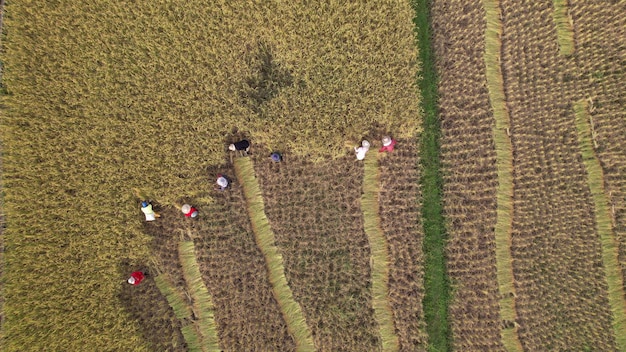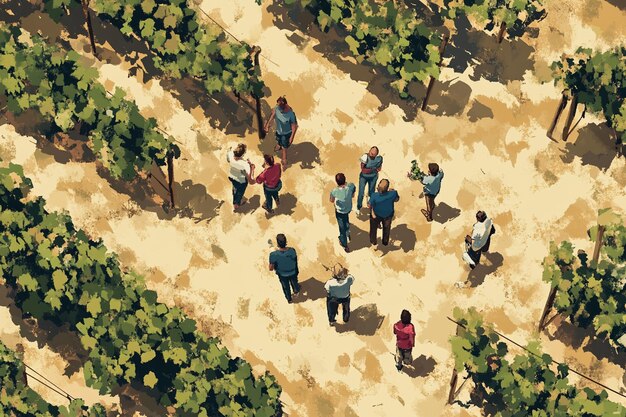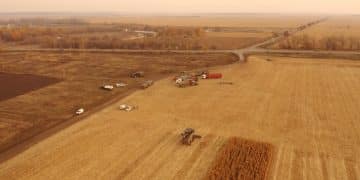Border Security Impact on Seasonal Farm Workers in 2025: US Labor Market

Increased border security measures are anticipated to significantly impact the flow of seasonal agricultural workers into the US by 2025, potentially leading to labor shortages, increased costs for farmers, and shifts in immigration patterns.
The implementation of stricter border security policies is poised to reshape the agricultural labor landscape in the United States. Understanding **The Impact of Increased Border Security on the Flow of Seasonal Agricultural Workers in 2025** is crucial for stakeholders across the industry.
Forecasting the agricultural labor market in 2025
Predicting the state of the agricultural labor in 2025 requires careful consideration of various intertwined elements. These include trends in immigration policy, advances in agricultural technology, and the evolving economic landscape that shapes both labor supply and demand.
Analyzing current immigration policies
Understanding the complexities of current immigration regulations is the first step in forecasting the scenario for 2025. The future supply of seasonal agricultural workers is heavily impacted by policies like the H-2A visa program–which allows foreign nationals to enter the US for temporary agricultural work—and the broader legislative approach to border control and immigration enforcement. Analyzing these policies is vital to knowing what’s coming.
Technological advancements and labor demand
The relationship between advances in agricultural technology and the demand for manual labor is complex and ever-changing. Automation technologies like robotic harvesting systems and precision agriculture techniques have great potential to lower the need for human labor. The pace of adoption and the affordability of these technologies will be critical in determining how much they transform the agricultural labor market by 2025.
- Automation in harvesting is impacting some labor roles.
- Precision agriculture reduces waste and manual labor.
- Adoption rates vary by crop and farm size.
In conclusion, projecting the state of agricultural labor in 2025 demands a thorough grasp of immigration policies, the pace of technological development, and economic variables. These elements will shape the circumstances for both agricultural employers and employees throughout the United States.
The ripple effect on seasonal agricultural workers
The impact on seasonal agricultural workers is far-reaching when border security gets tighter. These workers, who are vital to the planting, cultivating, and harvesting of crops across the U.S., face growing uncertainties and challenges.

Challenges faced by seasonal workers
Stricter and stricter border security rules create more obstacles and uncertainties for individuals looking for seasonal agricultural work. Workers may have to endure longer waits, increased expenses, and a higher risk of deportation when attempting to enter the country legally–or otherwise.
The potential for labor shortages
If border security measures get too aggressive, it may result in a noticeable drop in the number of seasonal agricultural workers who are available to fill positions. Labor shortages have the potential to cause widespread disruption to farming operations, which may result in in lost crops, reduce yields, and increased consumer prices.
The well-being of the US agricultural industry depends on addressing the complex issues impacting seasonal agricultural workers. This entails campaigning for just labor regulations, improving working conditions, and recognizing the important role that these individuals play in maintaining a reliable and successful food production system.
Economic consequences for the agricultural sector
There are numerous economic implications for the agricultural sector of increased border security. These effects encompass changes in production costs, market competitiveness, and the sustainability of farming operations.
Effects on production costs and market competition
The cost of labor may go up in response to scarcity caused by stricter border rules. This leads to increased production costs for farmers. In order to maintain profitability in the face of these higher expenses, farmers may be compelled to raise consumer prices, switch to less labor-intensive crops, or make investments in automation technology.
Long-term survival of smaller farms
Smaller and family-run farms that lack the financial resources to invest in technology are particularly at risk as a result of rising labor expenses. These farms could find it difficult to remain competitive in the market, which could result in farm closures and a consolidation of agricultural production overall. Additionally, the disappearance of smaller farms may have detrimental effects on rural communities and the cultural heritage of agriculture.

- Increased labor costs affect profitability.
- Automation requires significant upfront investment.
- Small farms may struggle to adapt and compete.
- Consumer prices may rise due to labor shortages.
In summary, an investigation of how stricter border security affects the agricultural sector’s economy is essential for developing strategies that promote innovation, sustainability, and fair labor practices. Farmers, communities, and consumers can gain from policies that balance the requirements of border control with the requirements of a robust and resilient food production system.
Alternative labor sources and strategies
To adjust for the probable labor shortages brought on by tighter border security, the agricultural sector is investigating a number of alternative labor sources and tactics. These strategies include expanding domestic recruitment efforts, streamlining labor regulations, and looking into foreign worker programs in other countries.
Enhancing domestic recruitment efforts
The agricultural sector can lessen its reliance on foreign labor by placing a greater emphasis on finding and training workers from within the country. Initiatives can include partnerships with vocational training programs, outreach to underserved communities, and campaigns to promote agricultural careers as viable career pathways for all.
Foreign worker programs and regulatory reforms
Agricultural employers are also looking into changes to foreign worker programs, such as the H-2A visa program, in an effort to make the process more accessible and effective. These reforms may entail streamlining application procedures, raising visa caps to reflect labor demands, and guaranteeing that all guest workers are treated fairly and equally.
Agricultural stakeholders may strengthen their resilience and adaptability in the face of evolving labor market conditions by implementing a multifaceted strategy that includes encouraging domestic recruitment, streamlining laws, and looking at foreign worker schemes. These initiatives guarantee that the agricultural sector will continue to be a thriving and reliable source of food and economic opportunity for future generations.
The role of technology in mitigating labor shortages
Technology plays a significant role in alleviating labor shortages and improving productivity in the agriculture sector. Automated machinery, precision agriculture methods, and data-driven insights have the potential to change farming operations and lessen the need for manual labor.
Adoption of automation and robotics
Farmers are progressively implementing automated and robotic technologies to carry out jobs like planting, harvesting, and weeding. These machines can greatly boost output, cut down on waste, and enhance the efficiency of agricultural operations. For instance, driverless tractors and robotic harvesters can work around the clock without getting tired and with great precision; this frees up human workers to concentrate on more specialized and strategic responsibilities.
Data-driven insights and decision-making
Farmers can optimize resource management, anticipate crop yields, and improve decision-making by using data analytics and sensors to collect and analyze data on soil conditions, weather patterns, and plant health. Farmers can boost production effectiveness and lessen the need for physical labor by using data-driven insights to guide their operations.
As technology continues to advance, its role in alleviating labor shortages and promoting sustainability in the agriculture sector will become increasingly important. By embracing innovation and investing in cutting-edge technologies, farmers can enhance their resilience, competitiveness, and environmental performance, ensuring a vibrant and sustainable future for agriculture.
Policy recommendations for a sustainable agricultural workforce
To find a long-term solution to the obstacles encountered by the agricultural workforce, especially in light of increasingly strict border control, policymakers and stakeholders must work together to implement policies that promote sustainability and resilience. These actions seek to address the underlying reasons for labor shortages, safeguard the rights of workers, while fostering innovation and economic opportunities.
Comprehensive immigration reform
Achieving thorough immigration reform that addresses the specific requirements of the agricultural sector is one of the most important policy recommendations. This should entail establishing a path to legal status for undocumented agricultural workers, streamlining visa procedures for seasonal employees, and modifying enforcement measures to enable agriculture to thrive while upholding border security.
Investment in workforce development and technology
Governments can make focused investments in programs that give prospective agricultural workers the knowledge and abilities they need to succeed in the modern agricultural landscape to promote workforce development. This includes funding for vocational training initiatives, apprenticeships, and educational programs that promote technology literacy and entrepreneurial thinking.
In order to address the issues facing the agricultural workforce, policymakers can guarantee the long-term sustainability, productivity, and equity of the agricultural sector by implementing comprehensive immigration reform, investing in workforce development, and creating enabling regulatory conditions.
| Key Point | Brief Description |
|---|---|
| 🚜 Labor Shortages | Increased border security may lead to significant shortages of seasonal agricultural workers. |
| 💰 Economic Impact | Rising labor costs and potential disruptions can negatively affect the agricultural sector. |
| 🤖 Technology Adoption | Automation and robotics can help mitigate labor shortages, but require investment. |
| 📜 Policy Changes | Comprehensive immigration reform and workforce development programs are essential. |
Frequently Asked Questions
▼
Heightened border security could drastically reduce the inflow of seasonal workers, leading to labor shortages in agriculture. This affects planting, harvesting, and the industry’s overall productivity, which can impact food supply.
▼
Technology such as automated harvesting systems and drone-based monitoring can increase efficiency and reduce the need for manual labor. Farmers can mitigate losses by investing in equipment and tech.
▼
Policy changes include comprehensive immigration reform that ensures legal pathways for foreign workers. Investment in training programs for domestic workers can also help stabilize the agricultural workforce.
▼
Farmers may experience increased labor costs and reduced production capacity. Smaller farms might struggle to compete with larger operations that can afford technology and automation.
▼
Alternative labor sources include recruiting domestic workers through vocational programs and exploring foreign worker programs in other countries. Regulatory reforms can also make these initiatives easier to implement.
Conclusion
In conclusion, the agricultural sector will potentially face substantial disruption from the anticipated rise in border security measures aimed at seasonal workers by 2025. These changes will necessitate forward-thinking policy adjustments, technology adoption, and strategic approaches to maintain a sustainable and robust agricultural workforce in the United States.





